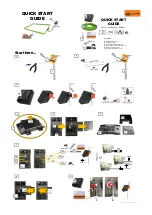
[page 6] | gpelectric.com
INTRODUCTION
1.2 OVERVIEW
Solar controllers, or solar charge controllers, continuously monitors the solar panel’s generating power and tracks the
highest voltage and current values (VI) in real time, enabling the system to charge the battery to maximum power. It’s
designed to be used in off-grid solar photovoltaic systems to coordinate operation of the solar panel, battery, and load,
functioning as the core control unit in off-grid photovoltaic systems.
This product features an LCD screen which displays the operating status, operating parameters, controller logs, and
control system parameters. Users can conveniently check parameters using the buttons and modify control parameters to
cater to different system requirements.
The controller utilizes standard Modbus communication protocol, making it easy for users to check and modify system
parameters on their own. An optional Bluetooth
®
adapter gives users access to remote monitoring.
With comprehensive electronic fault self-detecting functions and powerful electronic protection functions built inside the
controller, component damage caused by installation errors or system failures can be avoided.
1.3 FEATURES
•
Advanced multi-peak tracking technology. When the solar panel is shadowed or part of the panel fails resulting in
multiple peaks on the I-V curve, the controller is still able to accurately track the maximum power point.
•
Built-in maximum power point tracking (MPPT) algorithm significantly increases energy utilization efficiency of the
photovoltaic system, (about 15% to 20% higher than traditional PWM charging.)
•
Provides an active charging voltage regulation feature. At battery open circuit or lithium battery BMS overcharge
protection, the controller battery terminal will output the rated charging voltage value.
•
MPPT tracking allows up to 99.9% efficiency.
•
Uses advanced digital power technology to increase the circuit energy conversion efficiency to as high as 98%.
•
Supports multple battery chemistries, including lithium, sealed, vented, AGM, and flooded Lead Acid.
•
Current-limited charging mode. When the power of solar panel is too large and the charging current is higher than the
rated value, the controller automatically reduces the charging power so that the solar panel can operate at the rated
charging current.
•
Supports automatic identification of lead-acid battery voltage.
•
Features LED fault indicators and an LCD screen, which can display abnormal information, helps users to quickly
identify system faults.
•
Historical data storage function is available, and data can be stored for up to a year
•
The controller is equipped with an LCD screen allowing users to easily check device operation and statuses and
modify controller parameters
•
Supports standard Modbus protocol to meet different options.
•
Built-in over-temperature protection ensures that when temperature exceeds the set value of the device, the charging
current decreases linearly with the temperature, which reduces an increase in the controller’s temperature, avoiding
damage.
•
Temperature compensation and automatic adjustment of charge and discharge parameters help to improve battery
life.
•
Solar panel short circuit protection, battery open circuit protection and TVS transient protection.
Summary of Contents for GP-MPPT-PRO-60
Page 39: ......







































